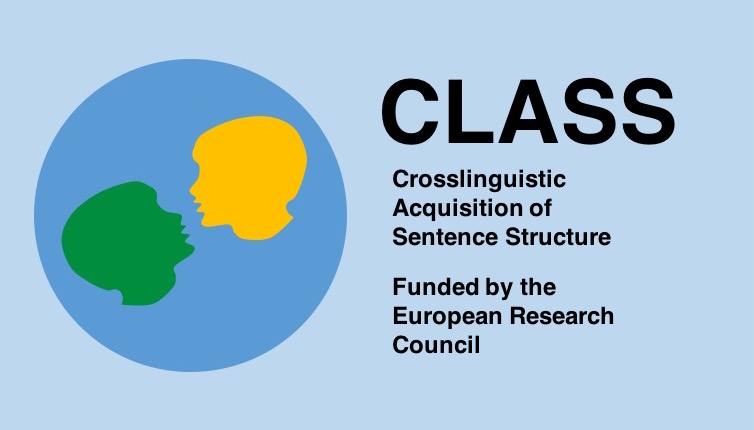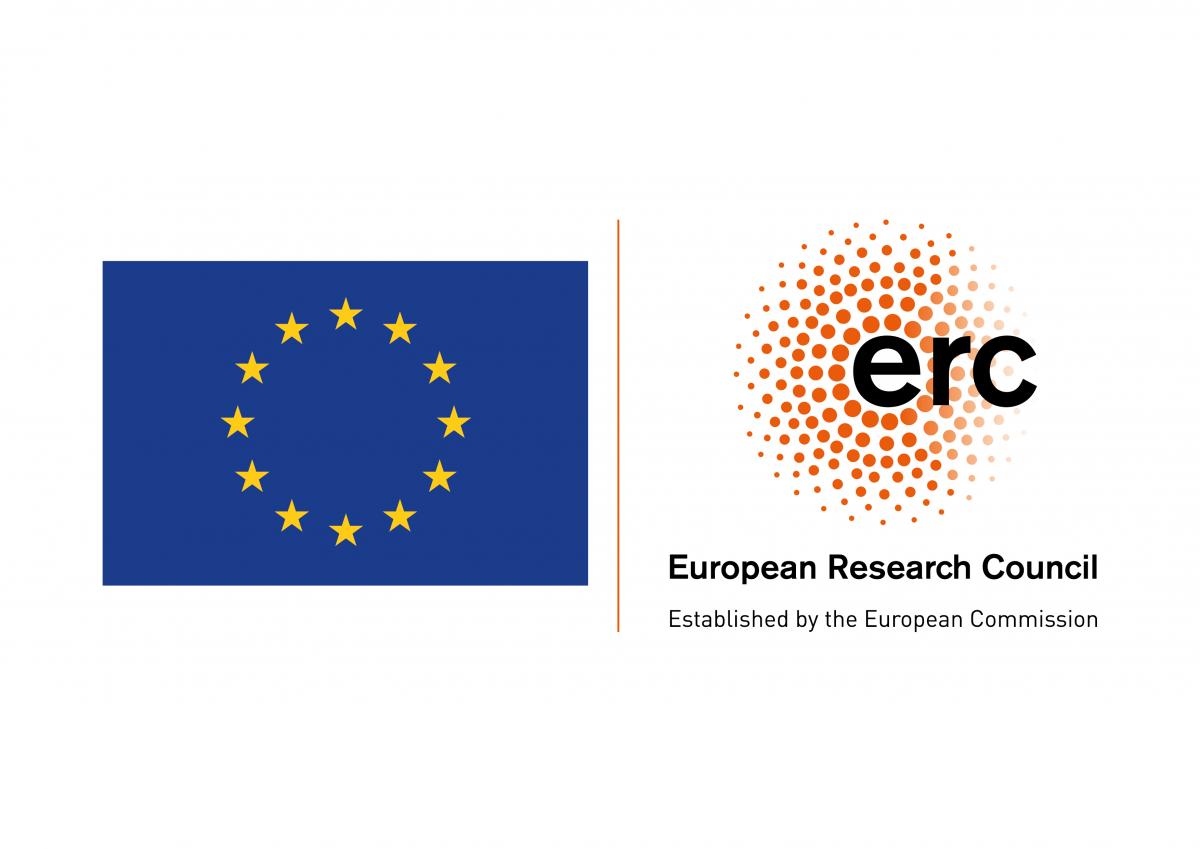

CLASS: Crosslinguistic acquisition of sentence structure
This project has received funding from the European Research Council (ERC) under the European Union's Horizon 2020 research and innovation programme (grant agreement no 681296: CLASS).
Project summary
How children acquire their native language remains one of the key unsolved problems in Cognitive Science. This project will answer a question that lies at the heart of this problem: How do children acquire the abstract generalizations that allow them to produce novel sentences, while avoiding the ungrammatical utterances that result from across-the-board application of these generalizations (e.g., *The clown laughed the man). Previous single-process theories (the entrenchment, preemption and verb semantics hypotheses) fail to explain all of the current English data, and do not begin to address the issue of how learners of other languages solve this learnability problem. The aim of the present project is to solve this problem by developing and testing a new unified cross-linguistic account of the development of sentence structure. In addition to the overarching theoretical question set out above, the research will address four key questions: (1) What do learners bring to the task in terms of cognitive-semantic universals?; (2) How do children form linguistic generalizations in the first place?; (3) Why are languages the way they are; would other types of systems be difficult or impossible to learn?; (4) What is the nature of development?. These questions will be addressed by means of four Work Packages (WPs). WP1 uses grammaticality judgment and elicited production paradigms developed by the PI to investigate the acquisition of basic transitive and intransitive sentence structure (e.g., The man broke the window/The window broke) across five typologically different languages: English, Kiche Mayan, Japanese, Hindi and Hebrew (at ages 3-4, 5-6, 9-10 and 18+ years). WP2 uses the same paradigms to investigate idiosyncratic language-specific generalizations within three of these languages. WP3 uses Artificial Grammar Learning to focus on the issue of language evolution. WP4 uses computational modeling to investigate and simulate development
Peer Reviewed Publications
Ambridge, B., Doherty, L., Maitreyee, R., Tatsumi, T., Zicherman, S., Mateo-Pedro, P., Kawakami, A., Bidgood, A., Pye, C., Narasimhan, B., Arnon, I., Bekman, D., Efrati, A., Pixabaj, S.F.C, Peliz, M.M., & Mendoza, M.J, Samanta, S., Campbell, S., McCauley, S., Berman, R., Sharma, D.M., Nair, R.B. & Fukumura, K (2022). Testing a computational model of causative overgeneralizations: Child judgment and production data from English, Hebrew, Hindi, Japanese and Kiche, Open Research Europe, 1(1) https://doi.org/10.12688/openreseurope.13008.1
Ambridge, B. (2022). Why Algebraic systems aren't sufficient for syntax: Experimental evidence from passives in English, Mandarin, Indonesian, Balinese and Hebrew. In S. Lappin & J-P. Bernardy (Eds) Algebraic Structures in Natural Language . [pdf]
Darmasetiyawan, I.M.S. & Ambridge, B. (2022). Syntactic representations contain semantic information: Evidence from Balinese passives. Collabra: Psychology, 8(1), 33133. https://doi.org/10.1525/collabra.33133 [open access]
Darmasetiyawan, I.M.S., Messenger, K. & Ambridge, B. (2022). Is Passive priming really impervious to verb semantics? A high-powered replication of Messenger et al. (2012). Collabra: Psychology, 8(1), 31055. https://doi.org/10.1525/collabra.31055 [open access]
Ambridge, B. (2021). Crazy New Idea: A Computational simulation of childrens language acquisition. In 3rd Conference on Language, Data and Knowledge (LDK 2021) (pp. 4.1-4.3). Schloss Dagstuhl Leibniz Zentrum fur Informatik. doi: 10.4230/OASIcs.LDK.2021.4 [open access]
Aryawibawa, I.N., Qomariana, Y., Artawa, K., & Ambridge, B. (2021). Direct versus indirect causation as a semantic linguistic universal: Using a computational model of English, Hebrew, Hindi, Japanese and Kiche Mayan to predict grammaticality judgments in Balinese. Cognitive Science, 45(4),e12974 https://doi.org/10.1111/cogs.12974 [open access]
Liu, L. & Ambridge, B. (2021). Balancing information-structure and semantic constraints on construction choice: building a computational model of passive and passive-like constructions in Mandarin Chinese. Cognitive Linguistics, 32(3), 349-388.https://doi.org/10.1515/cog-2019-0100 [open access]
Ambridge, B., Maitreyee, R., Tatsumi, T., Doherty, L., Zicherman, S., Mateo-Pedro, P., Bannard, C., Samanta, S., McCauley, S., Arnon, I., Bekman, D., Efrati, A., Berman, R. Narasimhan, B., Sharma, D.M., Nair, R.B., Fukumura, K., Campbell, S., Pye, C., Pixabaj, S.F.C, Peliz, M.M., & Mendoza, M.J., (2020). The Crosslinguistic acquisition of causative sentence structure: Computational modeling and grammaticality judgments from adult and child speakers of English, Japanese, Hindi, Hebrew and Kiche, Cognition, 202,104301, https://doi.org/10.1016/j.cognition.2020.104310 [open access] [stimuli, data, code]
Ambridge, B. (2020). Against stored abstractions: A radical exemplar model of language acquisition. First Language, 40(5-6), 509-559 https://doi.org/10.1177/0142723719869731 [open access]
Ambridge, B. (2020). Abstractions made of exemplars or You're all right and I've changed my mind. Response to commentators. First Language, 40(5-6), 640-659 https://doi.org/10.1177/0142723720949723 [open access]
Ambridge, B., Barak, L., Wonnacott, E., Bannard, C., & Sala, G. (2018). Effects of both preemption and entrenchment in the retreat from verb overgeneralization errors: Four reanalyses, an extended replication, and a meta-Analytic synthesis. Collabra: Psychology, 4(1), 23. DOI: http://doi.org/10.1525/collabra.133 [open access]
Researchers
Ben Ambridge (PI; now University of Manchester), Anna Samara (now University College London), Ramya Maitreyee (now University of Essex), Ayuno Kawakami, Tomoko Tatsumi (now Kobe University), Laura Doherty, Soumitra Samanta, Gaurav Saxeena (now University of Bristol), University of Liverpool; Inbal Arnon, Shira Zicherman, Dani Bekman, Amir Efrati, Hebrew University of Jerusalem; Ruth Berman, Tel-Aviv University; Pedro Mateo Pedro, Sindy Fabiola Can Pixabaj, Mario Marroquin Peliz, Universidad del Valle de Guatemala; Clifton Pye, University of Kansas; Kumiko Fukumura, University of Stirling; Bhuvana Narasimhan, University of Colorado Boulder; Dipti Misra Sharma, IIIT Hyderabad; Rukmini Bhaya Nair, IIT New Delhi; Liz Wonnacott, University of Oxford; Motoki Saito, University of Tubingen); Seth Campbell, University of Calgary); Stewart McCauley, University of Iowa; Colin Bannard, University of Manchester.
In preparation
Please email Ben Ambridge at the University of Manchester for current version
Samara, A., Wonnacott, L., Saxena, G. & Ambridge, B. (in prep) Learners constrain their linguistic generalizations using preemption but not entrenchment: Evidence from artificial language learning and computational modeling with adults and children
Maitreyee, R., Saxena, G., Narasimhan, B. & Ambridge, B. (in prep) Learners use semantics and statistics to acquire constraints on ergative marking in Hindi. Evidence from judgment and production studies with adults and children
Ambridge, B., Tatsumi, T., Saito, M., Bannard, C., Jones, S.D. & Kawakami, A. (in prep). Japanese children's case-marking errors with GA and WO: An elicited production study
Ambridge, B., Arnon, I., & Bekman, D. (in prep). He was run-over by a bus. Passive, but not pseudo-passive, sentences are rated as more acceptable when the subject is highly affected. New data from Hebrew, and a meta-analytic synthesis across English, Balinese, Hebrew, Indonesian and Mandarin.
Accepted in principle
Ambridge, B., Tatsumi, T., Saito, M., Bannard, C. & Jones, S.D. (accepted in principle). Who did what to whom in Japanese? How do children learn to mark participant roles in basic sentences? Developmental Science. [registered report]
Conference Presentations
Ambridge, B. (2021). Speakers' preference for more versus less-transparent causatives: Computational modeling, grammaticality judgment and production data from English, Hebrew, Hindi, Japanese and K'iche'. Paper presented at the Societas Linguistica Europaea, Athens (online).
Ambridge, B. (2021). Meaning constrains grammar. Evidence from eight languages. Paper presented at the Dubrovnik Conference on Cognitive Science (online).
Ambridge, B, & Liu, L. (2021). Balancing information-structure and semantic constraints on construction choice: A discriminative learning model of passive and passive-like constructions in Mandarin Chinese (and Balinese and Hebrew). Paper presented at Error Driven Learning in Language, Tubingen (online).
Ambridge, B. et al (2021). Speakers' preference for more versus less-transparent causatives: Computational modeling, grammaticality judgment and production data from English, Hebrew, Hindi, Japanese, K'iche' Mayan and Balinese. Paper presented at Agency and Intentions in Language, Gottingen (online).
Ambridge, B. (2021). Lexical restrictions with semantic motivations: Evidence from twelve alternations across eight languages. Paper presented at Lexical Restrictions on Grammatical Relations, Amsterdam (online).
Ambridge, B. et al (2021). Speakers' preference for more versus less-transparent causatives: Computational modeling, grammaticality judgment and production data from English, Hebrew, Hindi, Japanese and K'iche'. Paper presented at Expressing causality in L1 and L2, Lublin (online).
Ambridge, B. (2020). Disappearing causative overgeneralization errors across five languages: The roles of verb semantics and statistical preemption. Paper presented at the UK Cognitive Linguistics Conference, University of Birmingham (online).
Ambridge, B. et al (2019). Disappearing causative overgeneralization errors across five languages: The roles of verb semantics and statistical preemption. Poster presented (by Stewart McCauley) at the Boston University Conference on Language Development.
Maitreyee, R. et al (2019). Disappearing causative overgeneralization errors across five languages: The roles of verb semantics and statistical preemption. Paper presented at the Child Language Symposium, Sheffield.
Maitreyee, R. et al (2019). Disappearing causative overgeneralization errors across five languages: The role of semantics. Paper presented at the CUNY Conference on Human Sentence Processing, Boulder.
Maitreyee, R., et al (2018). Disappearing causative overgeneralization errors across five languages: The roles of verb semantics and statistical preemption. Paper presented at the Child Language Symposium, University of Reading.
.
.
.